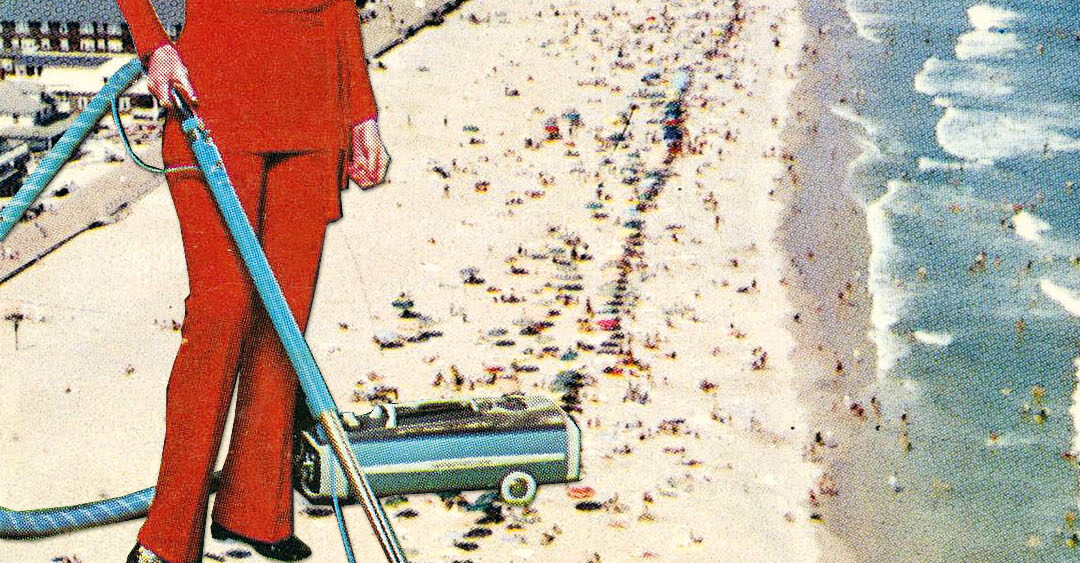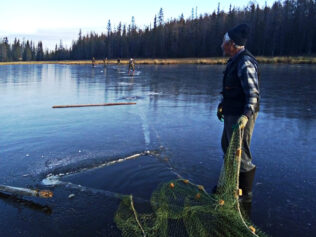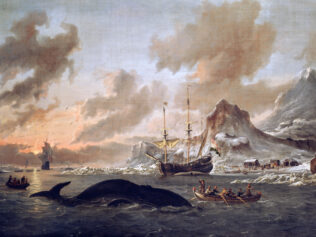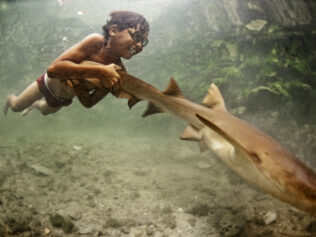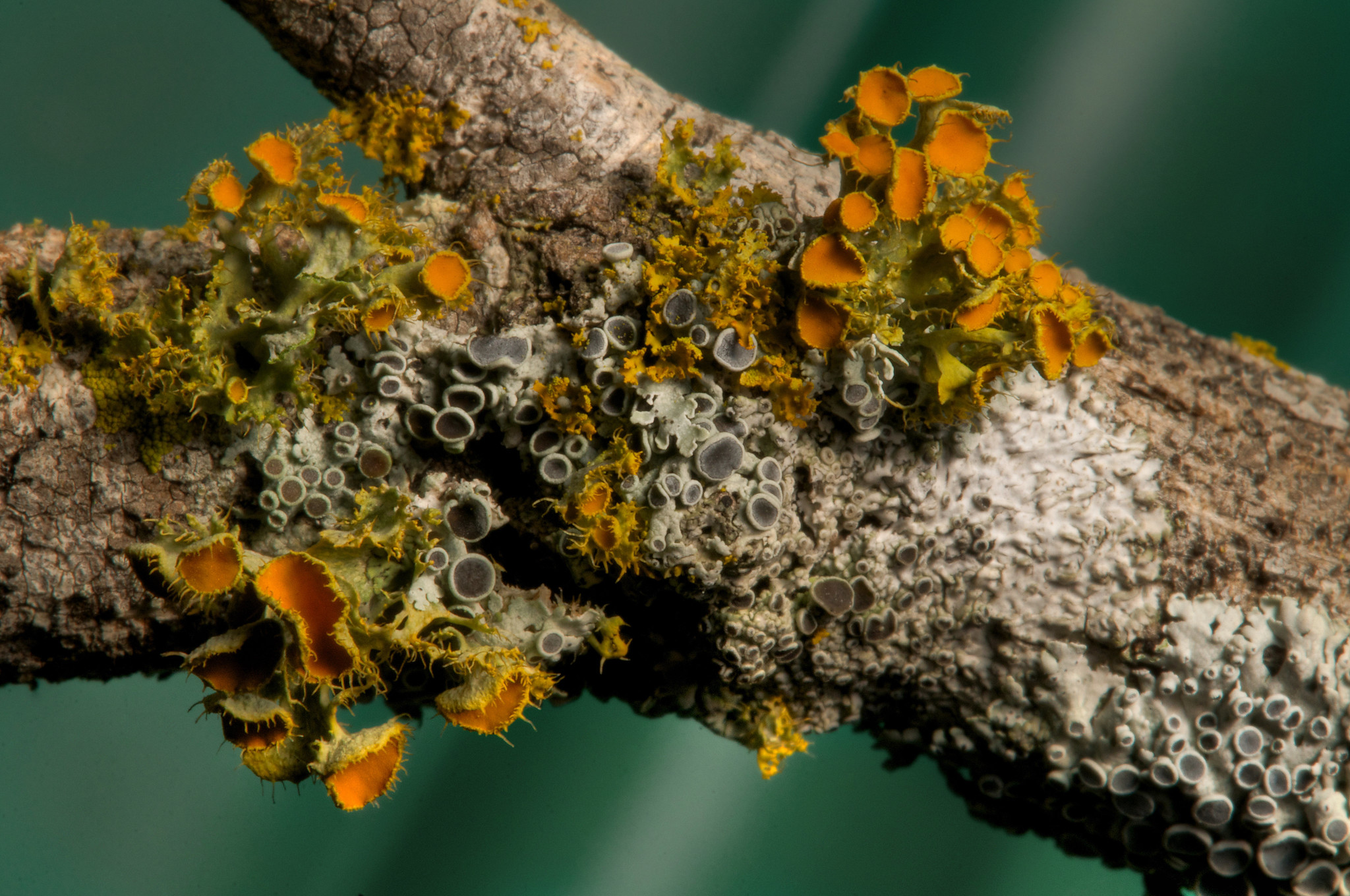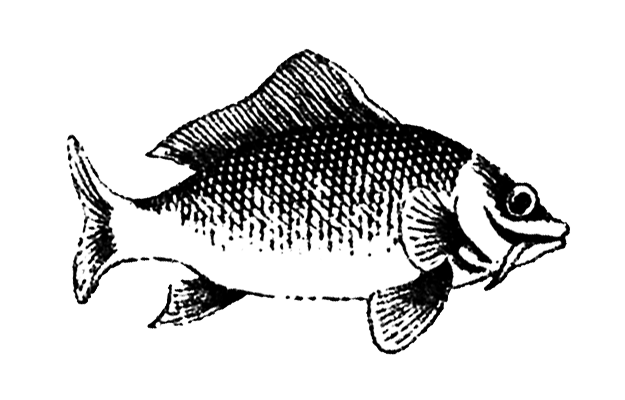
We sent our special correspondent Łukasz Kaniewski to find out more about the problem of plastic debris polluting the Baltic Sea. Turns out it’s not so bad, but it’s not great either. We must protect the sea – mainly from ourselves.
“Oh sea, our sea! We shall faithfully guard thee…,” I hum, getting off the train in Gdynia. This old mariners’ song has recently become remarkably relevant again. Only now it’s ourselves we need to protect the sea from.
“Humans have so little foresight,” says Dr. Barbara Urban-Malinga. “After so many decades, we suddenly realized that we’ve been creating all this pollution.”
We are sitting in her office at the National Marine Fisheries Research Institute in Gdynia. Urban-Malinga gets up and leaves the room for a minute. When she comes back in, she’s holding a glass lab vial in her fingers. Inside, there is a five-centimetre piece of black plastic bag.
“We found this inside a herring’s digestive system,” she explains.
“How big was the herring?”
“About 25 centimetres long.”
It’s as if someone found an A4-sized plastic bag inside my stomach, I think, feeling a bit uneasy.
“What kind of trash is found most often in the Baltic?” I ask.
“It’s worth mentioning that compared to the rest of the world, we find very few pieces of marine litter. That’s most likely because a few years ago, we organized a large campaign to remove fishing nets as part of the MARELITT project. We removed 300 tonnes of lost nets from the sea. Some people said it would be better if those nets remained on the sea floor and became a bedding for algae and seaweeds to grow on, but considering everything we have learned about microplastics so far, removing them was a wiser choice. Nets, just like any other plastic product, decompose into smaller and smaller pieces, and those tiny flecks are impossible to remove from water. It’s better to remove litter while it’s large enough for us to find it.”
Urban-Malinga shows me a detailed list of debris removed from the Baltic sea floor during a research project carried out by the National Marine Fisheries Research Institute. An abundance of plastic bags, pieces of cling film and plastic bottles. The list does not end with packaging. Further on, I see a Wellington boot, a shoe brush, a women’s tank top, a baseball cap, a piece of a broken baby car seat, a child’s jumper, a ship light guard, a sock, a piece of wire in a cotton sleeve, a plastic block, a pen, a safety helmet. All those objects were retrieved from deep parts of the sea, reaching from 19 to over 100 metres.
Whenever possible, the scientists strive to describe pieces of debris as accurately as they can: a plastic carrier bag from a popular Polish discount supermarket chain, found 23-metres deep; an empty Żywiec beer can found at 55 metres; a Tyskie can at 87 metres. A Żubr beer can made it the furthest, reaching an impressive depth of 97 metres. There is no doubt whose territorial waters they were in – we have marked our part of the Baltic Sea with our own brands of garbage. I feel a bit deflated, but Urban-Malinga tries to console me:
“The situation in the Baltic Sea is not that bad, you know.”
“Excuse me?”
“We have inspected 16 square kilometres of the seabed and taken over 130 samples. One-third of those samples did not have a single piece of debris in it; nothing. Other samples were relatively clean too, with an average of one piece of litter per five hectares. The Baltic Sea is much cleaner than the North Sea, not to mention the Mediterranean sea. The Baltic is a Special Area under MARPOL – an International Convention for the Prevention of Pollution from Ships.”
No less importantly, the Baltic Sea is largely isolated from other bodies of water, only exchanging a small percentage of its water per year with the North Sea. Ecologists were always very concerned about this isolation – all the sewage that flows to the Baltic Sea with river waters stays in one place. Moreover, should some major ecological catastrophe occur, the World Ocean would not help the Baltic Sea to self-cleanse.
“As it turns out, such isolation has some bright sides,” says Urban-Malinga. “Seas all over the world are becoming increasingly polluted, and ours could remain clean. All we need to do is take good care of it.”
***
Our conversation is interrupted by someone from the lab:
“We’ve found something in that cod’s gills. Basia, could you please help us identify it?”
In the laboratory, we look at the specimen through the lens of a microscope. The object is blueish, flat, irregularly shaped.
“Looks like a fleck of plastic,” says someone.
“Do you think so too?” I ask Dr. Urban-Malinga.
“It’s not enough to just look at it. We need a spectroscopic examination. We work with the University of Warsaw and with a laboratory in Germany. They can do it for us.”
“This tiny speck of plastic,” she tells me, once we’re back in her office, “was two millimetres long. That makes it a piece of so-called microplastic. This category includes bits of plastic sized less than 0.5 millimetres. Microplastics are a problem we have become aware of fairly recently.
“We know that plastic debris falls apart over time, gradually decomposing into smaller pieces. It has not been fully determined how those minute pieces of plastic affect living organisms, including humans. When submerged in water, they float on the surface at first, but once they become covered with algae, they get heavier and sink deeper down. If a fish eats a piece of plastic, it can remain in its digestive system if it’s large enough. The smallest pieces (sized 0.01 or 0.001 millimetres) can permeate the fish’s muscles. This has already been proved in Malaysia. Scientists tested samples of dried fish meant for human consumption and found flecks of plastic in them.”
“Does this mean that people are eating those microplastics?” I want to know. “And since it has managed to make its way inside the muscles of a fish, could it spread inside our muscles, too?”
“We cannot rule it out as a possibility. However, we don’t often consume dried Malaysian fish here, and the latest tests of Baltic fish have shown marginal amounts of microplastics in them.”
“What are the consequences of eating plastic?”
“We don’t know that yet. Plastics are usually mixed with various types of chemical additives. Plastic debris is a magnet for all kinds of chemical pollutants and some bacteria that can remain in our bodies. That’s one of the possible effects.”
“There are more?”
“It was recently established that nanoplastics, which are even smaller pieces, can infiltrate the barrier between blood and brain in fish. And that’s not all. Scientists also observed that it changes the fish’s behaviour. According to the research carried out by Karin Mattsson from Lund University, those behavioural changes were decidedly negative – nanoplastics made the fish with infested brains swim less eagerly around the aquarium they were placed in.”
“How many flecks of microplastic are there in Baltic Sea?” I ask.
“We don’t know that yet, but we are doing research on this topic. One of our ongoing projects involves collecting samples from the sea right next to the Vistula River’s estuary and in the Vistula River itself, just before its estuary. The samples are collected once a month. We launched the project last autumn and we will bring it to completion this autumn, so there are no results yet. But you can join the crew if you’d like to see how it’s being done. The next trip is scheduled a few days from now.”
***
Litoral is a small boat, less than 20 metres long. There are six of us on board, namely the captain, his assistant, and three scientists: Bartosz Witalis, Krzysztof Pawlikowski and Mariusz Zalewski. We leave the Gdańsk marina at 6.30am. I can’t hold back my excitement – my companions find it quite funny. Not even bothering to hide their amusement, they look at my thermal cycling outfit. Bartosz hands me an extra jumper and a beanie.
“A beanie?” I look at it, confused. “It’s supposed to be 24 degrees Celsius today.”
“Just wait and see. You’ll be putting them on in a minute.” And sure enough, after a short while, I’m wearing the hat.
It’s a sunny morning, so I’m enjoying the trip, despite the damp and windy weather. We’re not far from the shore, passing Sopot and Gdańsk. The sights are marvellous, although I’m distracted by a strange, unpleasant odour wafting all the way from the mainland. It’s a sharp smell, but with a hint of something sweet, organic even.
I walk down to the cabin. The scientists tell me about various research projects organized by the Institute. For example, they are trying to find out why the Baltic codfish is losing its body mass. They also analyse foreign species appearing in the Baltic Sea. It has recently been discovered that Rangia cuneata, a wedge clam native to the Gulf of Mexico, is living in the Vistula Lagoon. It probably arrived in Europe inside ballast tanks or chain chambers of ships coming in and out of the Baltic Sea. Mariusz, Krzysztof and Bartosz are discussing the sinking of a fishing boat a few days back. Luckily nobody died, but the wreck is still leaking fuel into the sea waters.
We talk about plastic debris too. Dr. Mariusz Zalewski coordinates the collection of samples.
“Plastic is a great material” he says. “It’s lightweight, malleable and strong. Hard to replace on an industrial scale. And there’s no point in hoping we can replace it easily. All we can do is better control what happens to it later, after we throw it away.”
We reach the spot where samples are collected each month. The scientists lower a special net, made of an aluminium box with an open bottom and a net made of long, dense mesh. It reminds me of a butterfly net, just longer and much denser. The net is hooked on to a steel lift rope, fitted with extra weights, and lowered down into the water. The waters here are around 10-20 metres deep. The probe is towed for half an hour, about two metres above the seabed. It keeps ‘wandering’ up and down, which allows it to collect samples from all water levels. Afterwards, the scientists get the probe out of the water and wash out everything it gathered. The water they used for washing will be later analysed in the labs.
Now it’s time for the second test, this time near the surface. The probe is no longer weighted, and two wings are now attached to the aluminium core. The net is half-submerged, writhing on the wind and waves like a Chinese kite.
“The point isn’t just to determine the number of microplastics in the water. We want to be able to compare the amounts found close to the surface and in deep waters,” explains Mariusz. “Plastic tends to float on the surface, but it can sink over time.”
He flushes the net and examines the container, now filled with washing water. We can see some plankton and bits of larger plants.
“Pines are in blossom,” mutters Mariusz. “But look, here’s some plastic.”
Indeed, among various green, brown and yellowish bits of scuff, there’s a one-millimetre speck of plastic, its vivid blue a telltale characteristic of a plastic bag.
“This one can be seen with the naked eye, but only when it comes out of the lab will we know how many smaller particles of plastic are really there.”
There’s still a few hours left before we get back to the shore, so we go back to the cabin for a nap. When I wake up and walk back up to the deck, I’m speechless. We are passing through the estuary of the Śmiała Wisła, a distributary branch of the Vistula River. It would be a stretch to call this place wild, but it is, without question, stunningly beautiful. I see an empty beach and the monstrous green cranes of the container port in the distance. On the other side of the river, there is an embankment made of huge concrete blocks, as if scattered by giants. Right next to it, several fishing boats are rocking gently on the water. The river is wide and majestic. Leaving its estuary into the open sea causes me to experience this vast calmness so intensely that I can hear symphonic music inside my head.
The only thing marring this experience is another whiff of that unpleasant smell. Perhaps it’s coming from the docks? Here and there, I can see pieces of garbage floating on the surface: a plastic carrier bag, a tennis ball, a long strip of plastic film. Over time, they will fall apart into smaller and smaller pieces, I think. The symphony in my head crumbles, too.
***
I meet Dr. Agnieszka Dąbrowska at the Faculty of Chemistry of the University of Warsaw, in the Laboratory of Molecular Biology. Dąbrowska is one of the scientists working in the research group led by Professor Barbara Pałys. In her laboratory, pieces of microplastics are further analysed. These bits of debris were collected during various research projects, not only on the Baltic Sea, but also on the Ligurian Sea and at Spitsbergen. We examine a sample under the microscope. Dąbrowska explains that this sample still awaits spectroscopic analysis in infrared.
“What is this speck?” I ask. “Is it plastic?”
“I don’t know.”
“What do you mean? Can’t the computer just analyse its electromagnetic spectrum and decide what category it belongs to?”
“Not yet. We are only now designing appropriate algorithms. We have already broken down spectra of many types of plastics, but their ageing in seawater alters their physicochemical qualities so much that they often cannot be identified anymore. Scientists only became interested in microplastics recently, and we still know very little about it.”
“And what can we do to reduce the amounts of microplastics in the sea?”
“Collect plastic garbage at the beach, for example.”
“Is that going to be enough?”
“Sadly, no. Apart from marine litter, fishing gear and bits of packagings, the largest source of microplastics in the sea are fibres of synthetic fabrics that are released into sewage systems every time we do laundry. The sewage goes into the rivers, and then it falls into the sea. We could set up filters to catch these fibres inside washing machines, but nobody does it. Fleece jumpers and blankets generate plenty of such fibres, not only when washed but also during general use. Another big culprit is the microbeads that are added to many beauty products. The US, UK, and several other countries have already banned those products from their markets, but they are still legal in the European Union,” says Dąbrowska.
Maybe one day we will have a law that prohibits the use of microbeads, but until then, we should remain vigilant and refrain from using cosmetics that contain them. These tiny flecks of plastic often hide under various names on the ingredients: polyethylene, polypropylene, polymethyl methacrylate, polyethylene terephthalate, polylactic acid, or nylon.
“It’s not realistic to expect the world to abandon plastic products completely, that’s impossible,” says Dąbrowska. “What we can do is try to reduce the waste we generate (any kind of waste is much easier to control on land than when it reaches the World Ocean) and research possible threats to the environment. Another marine ecosystem, called the plastisphere, is already emerging. Whole islands of drifting plastic waste are getting covered with living organisms. We are going to live in the era of the plastisphere and we need to prepare for it.”
I can’t possibly consider this conclusion very reassuring, but it’s not realistic to expect the situation to improve overnight of its own accord. The Great Pacific garbage patch, floating halfway between Hawaii and California, is already 1.5 million square kilometres large, which makes it roughly the size of Russia. It really does look like a new continent, and there are other similar patches on the waters of the World Ocean.
The only reassuring conclusion we can turn to is the fact that the Baltic Sea is faring much better than other seas. If we make enough effort, it could remain a relatively – for current world standards – clean sea. We just need to faithfully guard it.
Translated by Aga Zano


